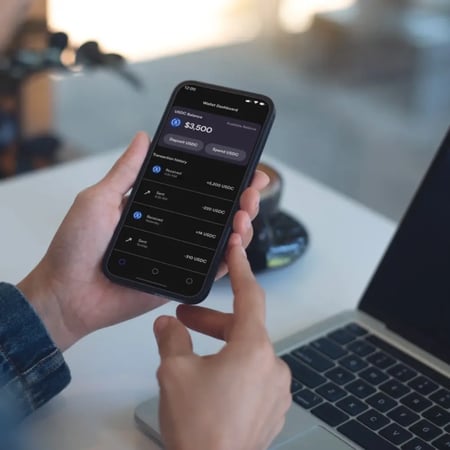
Meet Circle: The Fintech Powering USDC and Digital Finance
Circle is a global fintech company behind USDC, offering stablecoin solutions, digital wallets, and APIs to power fast, secure financial transactions.
Circle Internet Financial: Innovating with USDC and Blockchain
Founded in 2013, Circle is a leading global fintech company and the issuer of USDC, one of the most widely used regulated stablecoins. Circle plays a key role in advancing digital currency adoption by offering innovative solutions in blockchain-based payments, programmable wallets, and cross-chain protocols. Through its financial infrastructure, Circle empowers businesses and developers to move money at internet speed while maintaining compliance, transparency, and trust in the evolving digital economy.
Seamless, Compliant Payments in Just 60 Days – Ready to Transform?
Experience the power of a cutting-edge payment orchestration platform. Book your free demo today!
Frequently Asked Questions
We've summarised the most frequently asked questions to help you get started with learning more about Cybrid.
.png?width=100&height=100&name=Untitled%20design%20(8).png) Circle is a global financial technology company helping money move at internet speed. Their mission is to raise global economic prosperity through the frictionless exchange of value that is made possible via our stablecoins innovation (USDC) which is backed 1:1 with the actual dollar.
Circle is a global financial technology company helping money move at internet speed. Their mission is to raise global economic prosperity through the frictionless exchange of value that is made possible via our stablecoins innovation (USDC) which is backed 1:1 with the actual dollar.
Operating entities
Circle Internet Financial, Inc (ID#001115036)
Circle Internet Financial, LLC (ID#001489009)
For license information, refer to the appropriate subsection on their Legal & Privacy page.
Circle Internet Financial is a global fintech company founded in 2013.
Circle is headquartered in Boston, Massachusetts.
Circle Internet Financial was founded by Jeremy Allaire and Sean Neville. Jeremy Allaire took on the role of CEO, leveraging his extensive experience in technology and entrepreneurship, while Sean Neville served in various leadership capacities, contributing significantly to the company's strategic and technological development.
Circle Internet Financial, commonly known as Circle, is a financial technology company that operates in the digital currency and blockchain industry. Circle's primary activities include:
- USD Coin (USDC)
- Euro Coin (EURC)
- Cross-Chain Transfer Protocol (CCTP)
- Circle Programmable Wallets
- USDC issuance through Circle Mint & Circle Redeem API
-
Compliance & Regulatory Operations
Circle earns interest on the cash and cash equivalents held as reserves for USDC. These reserves are typically placed in low-risk, interest-bearing accounts or invested in short-term U.S. Treasury securities. The interest earned from these reserves represents a significant source of revenue for Circle.
Circle faces competition from various companies and entities in the digital currency and financial technology sectors. Some of the key competitors include:
Tether (USDT): As the issuer of USDT, one of the largest stablecoins by market capitalization, Tether is a direct competitor in the stablecoin market. USDT operates similarly to USDC, being pegged to fiat currencies like the US Dollar, but has different operational and reserve management practices.
Paxos (PAX): Paxos issues Paxos Standard (PAX), another stablecoin pegged to the US Dollar. Paxos is known for its emphasis on regulatory compliance and transparency, positioning itself as a trusted issuer in the stablecoin market.
Gemini (GUSD): Gemini, a cryptocurrency exchange and custodian, issues Gemini Dollar (GUSD), a stablecoin that competes in the same space as USDC. GUSD is also pegged to the US Dollar and emphasizes regulatory compliance.
Binance (BUSD): Binance, one of the world's largest cryptocurrency exchanges, issues Binance USD (BUSD), a stablecoin pegged to the US Dollar. BUSD is a significant competitor in terms of market reach and usage, especially within the Binance exchange ecosystem.
MakerDAO (DAI): MakerDAO's DAI is a decentralized stablecoin that is pegged to the US Dollar but backed by a mix of other cryptocurrencies instead of fiat currency reserves. It represents a unique approach within the stablecoin space and competes with USDC, particularly in decentralized finance (DeFi) applications.
These competitors offer similar products in the stablecoin market, with variations in their approach to reserve management, regulatory compliance, and integration within different cryptocurrency ecosystems. The competition among these entities contributes to the evolving landscape of digital currencies and financial technology.
Circle Internet Financial, the company behind the prominent stablecoin USD Coin (USDC), has garnered significant investment from a range of notable firms, showcasing its influential role in the digital currency and fintech sectors. The investors in Circle include a mix of venture capital firms, financial institutions, and technology companies, each bringing unique strengths and perspectives to support Circle's growth and innovation. Here are a few of the Circle investors:
- Pillar VC
- General Catalyst
- Breyer Capital
- Pantera Capital
- Digital Currency Group (DCG)
- IDG Capital
- Baidu
- Marshall Wace
- BlackRock
The diverse portfolio of investors, ranging from venture capital firms to global technology and financial giants, highlights the broad appeal and potential of Circle to revolutionize the way financial transactions and digital currencies are managed and utilized globally.
Circle Internet Financial, through its venture arm Circle Ventures, has made strategic investments in various companies and projects within the blockchain and cryptocurrency ecosystem.
Centre.io was established as a collaborative initiative by Circle and Coinbase, marking the start of the Centre Consortium. This consortium was designed as a self-governance body for the USDC stablecoin, playing a crucial role in the setup and ongoing maintenance of the USDC smart contracts. The purpose of Centre was to provide a structured governance framework for USDC, ensuring that its operations remained transparent, secure, and in compliance with regulatory standards.
However, as regulatory clarity for stablecoins in the U.S. and globally started to grow, the need for a separate governance entity like Centre became less critical. Recognizing this evolving regulatory landscape, Circle and Coinbase agreed to disband the Centre Consortium. Consequently, Centre ceased to exist as an independent entity, and Circle assumed all responsibilities related to the governance and operations of USDC. This transition streamlined the management of USDC, consolidating its operations under Circle's direct oversight.
The dissolution of Centre led to Circle holding all smart contract keys for USDC, enhancing its accountability as the sole issuer. This change not only simplified the governance structure but also strengthened compliance with regulations concerning reserve management. Additionally, it enabled Circle to focus on expanding USDC's presence on new blockchain networks, further solidifying its role as a leading stablecoin in the digital currency market.
This evolution reflects the maturation of the stablecoin sector and the increasing integration of digital currencies into the broader financial system, with regulatory frameworks becoming more defined and comprehensive.
For a seamless end-to-end USDC redemption experience, Cybrid stands out as a top choice, especially for businesses and entities seeking an integrated approach. Cybrid, with its Circle account, facilitates the redemption of USDC to both USD and CAD, catering to a broad range of needs.
Leveraging Circle USDC with Cybrid
With its seamless integration of Circle's stablecoin offerings, Cybrid empowers users to harness the stability, transparency, and security of USDC for various financial applications.

Trusted by Businesses Using Payments & Transfers Solutions
.png?width=200&name=Untitled%20design%20(18).png)
.png?width=200&name=Untitled%20design%20(17).png)
.png?width=200&name=Untitled%20design%20(16).png)
.png?width=200&name=Untitled%20design%20(15).png)
.png?width=200&name=Untitled%20design%20(13).png)
.png?width=200&name=Untitled%20design%20(12).png)
.png?width=200&name=Untitled%20design%20(9).png)

What Our Customers Say?
“Cybrid enabled us to reduce transaction processing time by 50%, improve operational efficiency by 40%, and achieve 3x growth within six months. Their seamless integration with our systems, robust compliance automation for KYC, KYB, and AML checks, and top-tier support allowed us to launch in production within twenty-two days."


